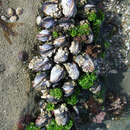Distribution
(
англиски
)
добавил Invertebrates of the Salish Sea
Geographical Range: Aleutian Islands to Baja California
- лиценца
- cc-by-nc-sa
- авторски права
- Rosario Beach Marine Laboratory
Habitat
(
англиски
)
добавил Invertebrates of the Salish Sea
Depth Range: Intertidal to 24 m
- лиценца
- cc-by-nc-sa
- авторски права
- Rosario Beach Marine Laboratory
Comprehensive Description
(
англиски
)
добавил Invertebrates of the Salish Sea
This mussel shell has a thick profile and the anterior end is sharply pointed. It has strong radial ribs and irregular transverse growth lines. Parts of shell are often eroded. The periostracum is usually heavy and blue-black. The shell interior is blue-gray, may be slightly iridescent. Attach to rocks by byssal threads.
- лиценца
- cc-by-nc-sa
- авторски права
- Rosario Beach Marine Laboratory
Look Alikes
(
англиски
)
добавил Invertebrates of the Salish Sea
How to Distinguish from Similar Species: The most similar local mussel species is the blue or bay mussel, Mytilus trossulus. M. trossulus has a smoother shell and is often wider than M. californianus for its length. Mature M. californianus are distinguished especially by the strong radial ribs and irregular transverse growth lines, which M. trossulus does not have. M. galloprovincialis lives in the southern end of M californianus' range, and is nearly indistinguishable from M. trossulus. Mixed clusters of M. californianus and M. galloprovincialis can be found on the open coast in southern areas. M. trossulus seldom has much presence in the northern wave-exposed coasts, so exposed mussel beds are mostly M. californianus.
- лиценца
- cc-by-nc-sa
- авторски права
- Rosario Beach Marine Laboratory
Comprehensive Description
(
англиски
)
добавил Invertebrates of the Salish Sea
Biology/Natural History: A very common inhabitant of the lower midlittoral, where it often dominates the substrate in waveswept areas. Specializes in living on large boulders and bedrock. Can move slowly from place to place by systematically breaking and remaking byssal threads. A filter feeder, filters 2-3 liters/hour. Spawns all year but spawning peaks in July and December in CA. A favorite prey of the seastar Pisaster ochraceous. Small mussels are eaten by seabirds and by the oyster drill snails Nucella emarginata,Ceratostoma nuttali, and Roperia poulsoni, although it is less vulnerable to predation by snails than is M. trossulus. In central CA parasitic isopods are often in the mantle cavity, as is also a pycnogonid and a pea crab. May become poisonous in summer months through ingestion of dinoflagellates, especially Gonyaulax catanella. Although this species may experience high flow in the intertidal environment due to wave action, byssal thread production seems to be limited to flows of < 50 cm/s. Mussel aggregations sharply reduce water flow within them and make possible the production of byssal threadsA study done on the related species Mytilus edulus found that the movements of individual mussels correspond to a L�vy walk pattern rather than a ballistic or Brownian pattern. This resulted in creating clusters with small-scale crowding, along with larger-scale dispersion. In this pattern mussels maximized the number of mussels immediately close to them while at the same time minimized the number of mussels in the general area.
- лиценца
- cc-by-nc-sa
- авторски права
- Rosario Beach Marine Laboratory
Habitat
(
англиски
)
добавил Invertebrates of the Salish Sea
Common in intertidal zone 3. Less common subtidally. Clings to rocks in wave-exposed areas, especially on the open coast.
- лиценца
- cc-by-nc-sa
- авторски права
- Rosario Beach Marine Laboratory

